 There a plenty of reasons why lard is so good for us
There a plenty of reasons why lard is so good for us
Its frustrating to hard boil eggs and then they don′t peel
I have been hard boiling, peeling and chopping up to 10 dozen eggs in about 3 hours for the last 10+ years as this is what we use for the first meal for any chicks we buy as it makes for an easily digestible source of food for them.
I also set aside a dozen unpeeled in the fridge for me and my husband for those quick snacks.
Over these years I have developed several techniques I feel really work to make the eggs easy peel.
The process starts with cleaning the eggs as I don′t wash eggs until I′m getting them ready to use or sell.
After washing 3-4 dozen they go into a large pot with water and onto the stove. They heat up and boil for 15 minutes. During this time I am working on getting the next batch clean and boiling.
By the time batch 1 is finished boiling, all of the eggs have been washed and are ready to go into the pots.
After the 15 minutes Batch 1 is taken off the stove and drained of hot water, cold water added to the pot and then drained again and then the eggs are then dumped into the sink with more cold water to further halt the cooking process.
/media/kevin/USB20FD/eggs1.jpg
SECRET #1: WATER
This is a key as the water does multiple things
The eggs sit in the water in the sink waiting to be peeled.
If you are not going to peel the eggs right away, once cool they can go into the fridge where my eggs easily last for 2 weeks.
SECRET #2: SMASHING THE EGG
As I pick up each egg, I smash it against the side of the sink multiple times. This helps to break up the egg shell but leave it attached to the membrane.
Then I pinch the shell and hopefully pull the membrane away form the egg. Some eggs will peel with just the shells breaking in half others will require several pinches at the different parts of the shell to get all the larger pieces off. Once the egg is peeled I then give it a final dunk in the cold water to rinse off any bits of egg shell and into the bowl it goes with the rest of the naked eggsSECRET #3: Just let it go
After all of these years and thousands of eggs the biggest secret is that some eggs just don′t peel and you need to let it go!I have come to the conclusion that it is either the placement in the pot during boiling or something inherent in the egg itself that causes the hard peeling.
I am actually leaning more towards the second reason as not all batches have hard to peel eggs. The last round of 9 dozen eggs, done in 4 batches, there were 2 hard peelers and another 2 that had a piece of egg white missing.
Nutrition is such a key and if a nutrient is out of balance when the egg was finishing its development inside the hen this could explain why some eggs don′t peel well.
Like us humans, chickens developed in a space where the nutrients were in an abundant, balanced state and they were eating a variety of nutrient dense foods to take in all of the nutrients that they needed and more so.
In the commodity egg market where price is king and producing eggs as cheap as possible is the norm, the feed the hens get is a balanced ration of the minimal amount of nutrients that the average hen needs to stay productive for the 2 years she is in production.
The ration does not account for the hens that need a little more of this or that nutrient as such the hens are constantly stealing from their reserves to produce eggs.
In a regenerative agriculture setting where the hen is on pasture, she can forage to balance her diet and acquire the abundance of nutrients, from nutrient dense foods, that will help her to thrive, not just survive.
Remember its not just what you eat its what your food eats

Self care is what you do for your health, both mental and physical. This can be as simple as spending a few minutes browsing through a magazine that you enjoy or taking a walk or going to a gym.
Self care is stress management. The better we are at handling all of the stresses that affect us the healthier we are. The stressors can be everyday activities like work, driving, kids and family or seasonal like allergies or illness related. These are things that can impact your mental and/or physical well being.
Self care is not selfish as the better you take care of yourself the more you can take care of others. It′s like putting on your oxygen mask in an airplane so you can then help others to get their oxygen masks on.
Self care is compassion for yourself for not beating yourself up when you do things that you know you shouldn′t like staying up late to read a book (one of my big ones) or having that extra serving of ice cream and cake. We all do these things they are part of being human.
Self care is eating healthy. Physically feeding your body the essential nutrients each day helps the body to minimize stress by always having on hand what it needs to perform at its best. Also not eating trigger foods that cause additional stress is part of eating healthy
Self care is doing things for yourself that you enjoy. I spent 10 minutes coloring the pansy and at the end I had a wonderful feeling of calmness and now each time I look at it I get a satisfied feeling that I created a little bit of beauty.
Self care is rejuvenating. Burn out happens when you physically, mentally and emotionally no longer care. It happens over time. But incorporating self care into your daily routine will prevent that overload. Self care may even steer you down a different path.
Self care is time for reflection. A gratitude practice where you review your day and think or write down what you are grateful for is great for bringing joy. I also like to ask where can I improve as a gentle prompt for me to be aware of my little habits that cause stress and look to eliminate them.
Self care is down time. There are days where we may only get 5 minutes to lock ourselves in the bathroom and not think, just be and afterwards we can take on the world again.
Self care is nourishing to the mind, body and soul. Balance and well-being are critical to having a fulfilling life.
Self care is healing. By taking the time to take care of yourself you dissipate stress and therefore allow your mind, body and soul to get rid of the trash.
Self care is understanding that you are human. We all make mistakes and could be better in multiple ways. I like telling myself that I am doing what I can as I can
Self Care is planning. By making the decision a head of time (meal planning, weekly scheduling) you are taking care of your future self.
Self care is a daily activity to decrease your stress. Stress is a daily thing and we need to release it daily.
Self care is more than survival. It′s about succeeding with ample vim and vigor for the next opportunity.
When your body, mind, and soul are healthy and harmonious, you will bring health and harmony to the world& — not by withdrawing from the world, but by being a healthy, living organ of the body of humanity. B.K.S. Iyengar
Tired of tasteless grocery store chicken?
Chicken that was raised in cramped, disgusting conditions.
We will open up for Early Bird Chicken pre-orders on Monday March 20th.
All the particulars will be spelled out and you can gauge how much freezer space you will want to set aside for your birds that will be processed in June and July.
And then you can be eating scrumptious, pasture raised chicken for the next 12 months.
A friend just gave me this recipe for Paprika Chicken and it looks delicious. I do still have a few chickens left and one is going to find its way into this recipe.
Paprika Chicken
Ingredients:
Let me know how you like the recipe.
Also, if you have a favorite recipe you are willing to share I would love to try it out.
Check your inbox on Monday for the Early Bird Pre-order specifics.
I was feeling bored with dinners again, I didn′t feel enthused about cooking and none of the recipes in my box sounded appetizing.
So what did I do. I read a recipe book. Nourishing Traditions to be exact.
The book written by Sally Fallon is chocked full of good advice for eating a nutrient dense diet and the recipes are delicious.
I now have a list of over 30 recipes to try. Everything from appetizers and main dishes to drinks and desserts.
So back to my quest for something for dinner!
Always on the lookout for an idea to create another version of comfort food, This recipe reminded me of KFC.
Kevin and I were out shopping recently and our usual dinner place was closed, and so was the 2nd at which point we just wanted to eat something and ended up at KFC.
While it was nice to relive a childhood memory it wasn′t as good as either of us remembered AND now that we know more about what is actually in the food like stuff we ate, we both decided that this was better.
Breaded Chicken Breasts
8 skinless chicken breasts
1 ½ cups unbleached flour
1 tsp pepper
4 eggs, beaten
2 cups whole grain bread crumbs
½ cup Parmesan cheese
about 4 Tbs butter
about 4 Tbs extra virgin olive oil
1. Pound the chicken breasts lightly with the small prong side of a meat hammer.
2. Mix flour and pepper together on a plate, have eggs beaten in a bowl and have bread crumbs and Parmesan cheese mixed together in another bowl.
3. Using tongs dip each chicken breast in the flour mixture, then the beaten egg and then in the bread crumb mixture.
4. Saute a few at a time in butter and olive oil, about 7 minutes per side, being careful not to burn.
5. Transfer to a heated platter and keep warm in the oven until ready to serve.
This is one that is now in my recipe box to repeat. Fairly simple and easy to do.
Let me know how this recipe worked for you.
These are the first herbs that I reach for in just about any dinner that I make. They can be used singly or in combinations with other herbs and spices. They can go with any meat, have health benefits and can be grown in our climate with little or no help.
Meat and eggs from Akyla Farms taste great alone but with the addition of herbs and spices the aroma is mouth watering and the flavors are amazing.
Typical grocery store meat is very bland and non-distinct as the foods that feed the animals are not nutrient dense to begin with, it is all the extra nutrients in animals that we raise regeneratively that creates the flavor of the meat and eggs. It is this awesome flavor that we want to enhance but not cover up with spices and herbs.
In the array of herbs and spices in my kitchen cupboards the top 4 are oregano, thyme, basil and rosemary.
These four herbs have been used for centuries to not only flavor dishes but also to help heal and/or prevent health problems. The health properties include all things anti- (inflammatory, cancer, oxidant, fungal, bacterial, parasitic), boosting mood, lowering blood pressure, cognitive stimulant, stress reliever, improve memory performance, regulate blood sugar and many many more.
Oregano, thyme, basil and rosemary can make a great kitchen garden where you can easily pick off the leaves or stems as needed from your plants in the kitchen window or right outside your door. My Mom has a rosemary that does quite well in the outdoor garden without any help from us. With my busy life this is my kind of garden.
In order to get the best out of each of these herbs here are some simple do′s and don′ts.
Basil
Oregano
Rosemary
Thyme
I have used all 4 of these on our chicken with great results. Adding a little onion or garlic will also complement the herbs. Last nights dinner was baked chicken with sea salt, black pepper, dried minced onion and dried rosemary. A simple combination that brings out a lot of great flavor and I will do it again.
WhatIt′s for dinner is a constant battle I face just about every day. There are many days where I am at the grocery store in need of a dinner idea that is not only good but meets my standards of organic and nutrient dense and on my budget. Here are 5 different ways that I pull it off.
1) In the grocery store go to the aisle with the boxed dinners. Find one that looks good and flip it over to look at the ingredients. Most boxed dinners are simple meat, carbohydrate (usually potatoes or rice), vegetables and a seasoning mix. I have the meat in my freezer or already thawing so I then pick up the rest of the ingredients.
2) Create a list of meals that is separated by protein. This way you can scan a list and jog your memory of what you have not made in a while. Also It′s a great idea to help with meal planning as then you can pick up items during the next grocery shopping trip and get any necessary ingredients thawed in time for dinner.
3) Know what is in your freezer. One of the problems with chest freezers is that items get lost in their depth. Keep an inventory of how many and of which meat cuts, packages of vegetables, french fries, etc. That way you still know if you have something or not to be able to pull off that quick meal before taking your kid to practice.
4) Meal Planning. The night before your grocery shopping sit down and plan X number of meals. I can plan out a whole months worth of dinners in about a half hour. Start with just 1 or 2 to get the hang of it and gradually work your way up to the number of meals before your next regularly scheduled grocery trip. Then you can double check recipes, freezer quantities and the staples to make sure you have all the ingredients.
5) Internet. This last one is great just about anywhere with our cellphones as we can search for recipes at the last minute or plan ahead and pick up those obscure items that we donIt′t keep in stock.
These tips have allowed me to be more creative and serve ideas that I would never have thought of. Hopefully they will help you as much as they have helped me to feed my family.
Our freezer shelves are almost bare of meat, except for chicken, as we had expected to have the pigs and bull butchered months ago. Pigs just saw the butcher last week and the bull is still waiting for the butcher. So now I am making things with chicken that I would normally do with another meat. The other night I really wanted a comfort food and Tuna Noodle came to mind but I have chicken and more chicken so I used what I had. It was a success and will be doing it again. Here is my recipe.
Chicken Noodle Casserole
2 Akyla Farms Chicken leg quarters
1 can Cream of Mushroom Soup
1 package frozen peas or can of peas (drained)
1-16 oz package of noodles
Salt and pepper to taste
Preheat the oven to 350 degrees.
While cooking the noodles, cut the meat into bite sized pieces and brown in a skillet. I used my large cast iron
skillet so I didn′t need to use an extra baking dish.
Drain the noodles when done and add to the meat when it is cooked through. Mix in the other ingredients and
bake for 20 minutes.
Notes:
With all the negative info coming out about the rancid vegetable oils and the imbalance of omega fats in our diets how do we get rid of the vegetable oils that are so bad for us but yet cook our foods.
 There a plenty of reasons why lard is so good for us
There a plenty of reasons why lard is so good for us
We have been led to believe that all fat is bad for us when in reality saturated fats from pastured animals are some of the best fats
for us. What is bad are the fats that are unsaturated as they go rancid and create damage.
If you are getting a whole or half pig from us then don′t forget to get your lard back as it is so easy to render and have a great supply
of oil to cook and bake with.
I render my lard in the slow cooker, but it can also be done on the stove.
For best and quickest results thaw the lard so it can be cut into smaller chunks and put them into the slow cooker or large pot, turn
the heat on low. The melting point of lard is about 100 degrees F.
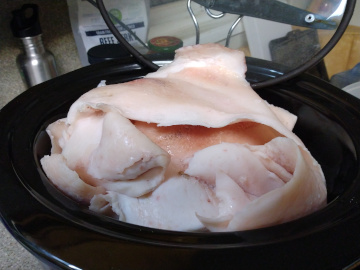 In a few hours check on it. If there is enough clear liquid to drain off then using a heat safe container and a turkey baster transfer
any of the clear liquid over. Let the rest of the lard to continue to cook until there is only small scraps left, cracklings, that can then
be strained out and eaten or given to the chickens as a great treat.
Tip: only heat the lard once to render it and get the rendered lard out of the heat to keep it as white as possible. In the picture the
lard in the darker jars was heated multiple times.
Once my quart jars are full, I put lids on them, let them cool and then into a fridge. If using a freezer safe container the freezer is
also an option.
Don′t worry if you have so much that you think you will not go through it as it has a long shelf life and there are plenty of other
uses than cooking.
In a few hours check on it. If there is enough clear liquid to drain off then using a heat safe container and a turkey baster transfer
any of the clear liquid over. Let the rest of the lard to continue to cook until there is only small scraps left, cracklings, that can then
be strained out and eaten or given to the chickens as a great treat.
Tip: only heat the lard once to render it and get the rendered lard out of the heat to keep it as white as possible. In the picture the
lard in the darker jars was heated multiple times.
Once my quart jars are full, I put lids on them, let them cool and then into a fridge. If using a freezer safe container the freezer is
also an option.
Don′t worry if you have so much that you think you will not go through it as it has a long shelf life and there are plenty of other
uses than cooking.
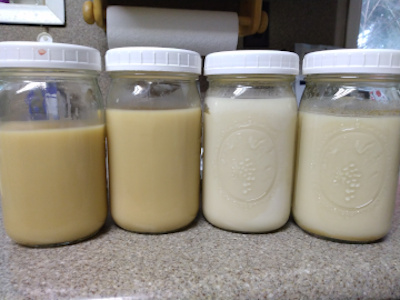
Last week saw some of the worst flooding the Skagit Valley has seen in many years. We at Akyla Farms stressed over the thought of moving the pigs and cows off of the Birdsview property for their safety but with one of the recent floods being a 36 ft crest in Concrete we figured we didn′t need to evacuate but be ready to move them to higher ground on the property. In the end the pigs didn′lt need to be moved at all and the cows wisely stayed out of the low areas.

|
1 of 2 spots of water over driveway |
There was some high anxiety time on Monday morning before I made it to Birdsview and saw where the waters had risen to. Once I had counted the 10 pigs and saw the three beeves the stomach slowly released its knot. I did spend the day with Gina as I wanted to make sure the river had crested before coming home. The Skagit River did crest at 38.93 feet so now we know where we need to have livestock at this level of flood and what kind of damage to expect.

|
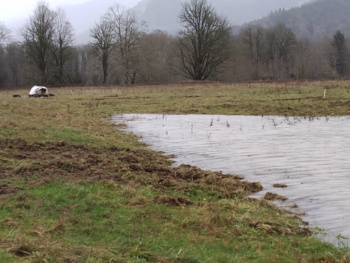
|
Lower field, river is usually on |
At the crest pigs were about 200 ft away |

|
|
| Day after |
It took until Saturday for the low spots on the property to drain enough for us to assess any damages. We did find 3 sections of fence down 1) flow of water laid the fence down and the addition of sand buried the fence 2) knotweed and leaves forcing the fence down and burying it and 3) a downed tree. All were fairly easy to fix to the point of keeping the cattle in and with a little more work and some golf tees the sections will be back to where they need to be. There are a few other sections that are full of debris on the fence that just needs to be cleared. So overall we were extremely thankful as we didn′t loose any animals and the damage to the fence is slight.
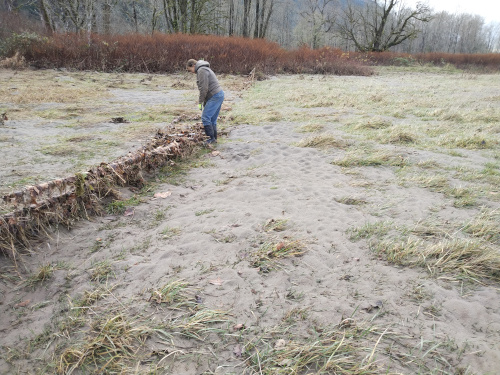
|
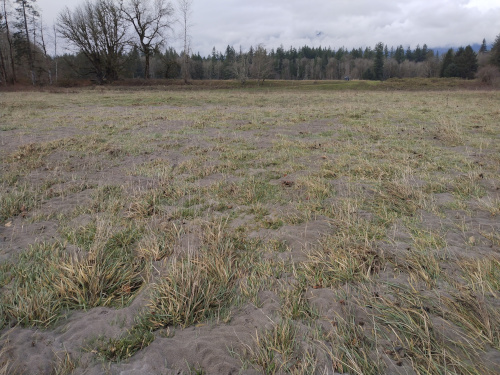
|
Starting to clear the fence |
New sand brought by the river |
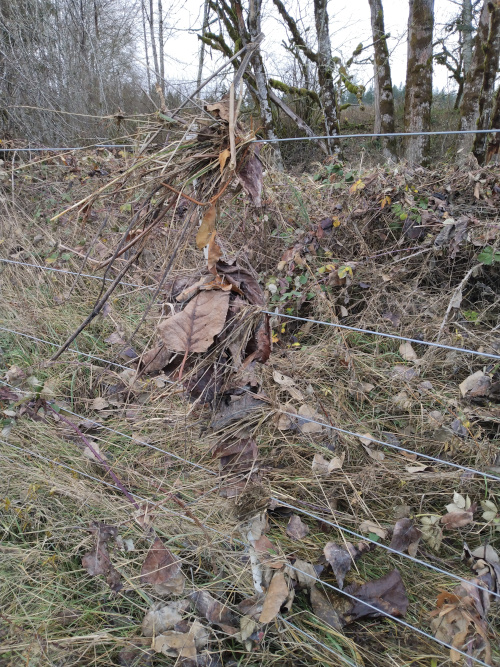
|
|
| Some debris pushed up against a post by the flowing water |
Summer is nearly over and I′m not ready. I′ve been canning beans, turning out quart after quart of chicken stock, blanching and freezing corn, making peach jam and apple syrup (it was supposed to be jelly, but…) and I still have 15 pounds of blueberries in the freezer to process. The beans are still growing faster than I can pick them and the tomatoes are piling up in the freezer, waiting for a moment when I can tackle making gallons of marinara.
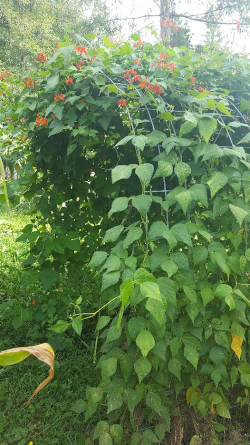
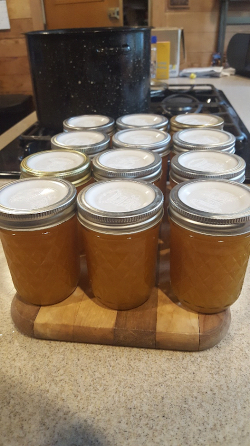
The fruit trees in the orchard have mostly given up their goods, although the Italian Plum still has some lovely fruit on it and the Quince and Fig trees aren′t quite ready for harvest. The peppers in the greenhouse got a terribly late start but hopefully will produce for a while, since they′re protected from frost. The grapes are ready, as well!
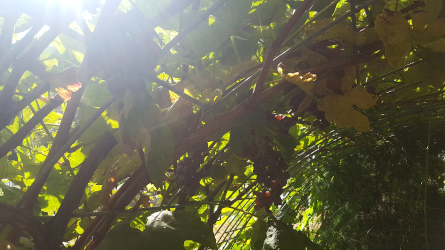
Other projects have been slowly getting accomplished, as well. We got the roofs of two of the goat shelters replaced with shiny new corrugated metal and a 5 gallon bucket of roof mastic painted onto the others will prolong their life spans. As long as I was doing those, I went ahead and painted the roof of my horse trailer and our 45 year old camper, which at this point is a bit of a rolling museum! They sure don′t make them like they used to.

The roof panels reclaimed from the goat shelters are going to be repurposed into raised beds and the fall crops of turnips, beets, kale, and other greens are already started, just awaiting transplanting. This will be the first time I′ve ever attempted a fall garden and I′m very excited to see how they do, especially since my spring turnip crop was all but decimated by root worms. Now I know about those!
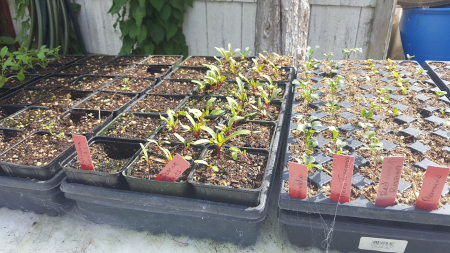
The goats are beginning to show signs of winter coats growing in. The kids are nearing weaning age, and soon Jax will be starting his career as a herd sire, first for Akyla Farms, then coming home to our does. Linus will get one more chance with Sabrina before being retired to freezer camp. With the onset of weaning, I′ll be able to keep more milk from Sabrina and Allykat and begin turning out a lot of cheese! I′m setting myself a goal of turning out at least one cheese every 2 weeks for as long as the milk holds out.
Our truck was out of commission for over a month with needing the transfer case rebuilt but now we have it back and I can start bringing in woodchips for the chicken coop, goat pens, and mulching the strawberry patch. I use them to bury last seasons plants and next seasons grow right up through them. Every year, my strawberries take over more of the beds around the greenhouse and produce more berries-a good problem to have!
Soon it′ll be time to start closing up the house, as I leave the windows open all summer long to the fresh breezes, and giving everything a thorough cleaning. Housework tends to get away from me when it′s nicer outside! A lot of weekends have been used up on time-consuming (but important) projects and I′m looking forward to just throwing my kayak in the water and paddling off without feeling guilty.
I′m hoping to get more soaps made this fall, as well as get something going on the site to sell them so stay tuned for that, and soon, I′ll be showing some ways to eliminate using toxic cleaners in the home. I just need to grab a few more beans first!
Happy July, all! We′ve been super busy around the farm with goat kids and gardening and working on projects like reroofing the main goat shed before the rains come back. The heat wave was a bit of a drag, since our 101-year-old house has no air conditioning. I parked a fan blowing across the dining room floor to keep the cats from melting and they all lay in front of it for days. Flip is not impressed with the heat

All the animals had multiple water tanks and there are plenty of trees on the property for shade. We took a lot of cold showers to try to help sleep, as well, which brings me to the topic of the moment … soap!
Many months ago, I decided to try my hand at making soap for our family, to try to help with expenses and because I like to know exactly what ingredients we are using on our bodies. After watching several videos and reading a book or two, I made my first batch, a peppermint-oatmeal soap. It was a hit AND I really enjoyed the process. It reminded me of making pastry cream (I have a degree in culinary arts).
There are a couple of ways to make soap at home. There is a melt and pour variety and then there is the way I do it, with various oils and butters, and sodium hydroxide-commonly known as lye. I prefer doing it this way because it allows me to change up recipes and ingredients any way I choose. I use a tool called a lye calculator (found online) to calculate new recipes and be sure I am using the correct amount of lye. This is important because lye can be dangerous if mishandled/mismeasured. In the final product, there is no lye as it chemically changes when mixed with the different oils (called saponifying) and becomes soap.
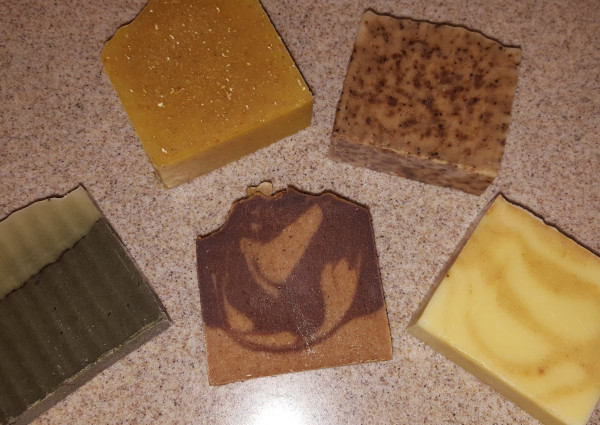
Fairly recently, a few people suggested I sell some of the soaps I make, and after some thought, it seemed like a
workable idea. It only takes a couple of hours to make a 3-pound loaf, including cleanup, and a few days of sitting
in the mold before I cut it into individual bars. The real wait begins then, as the soap bars need to cure for 6 to 8 weeks.
The longer they sit, the harder they become, and the longer they last, so there′s no good reason to try to rush this part.
 As I build my inventory, I will be listing the soaps on the Give Me Faith Farm website, but until then, a small number are
being carried by 5B′s Bakery in the town of Concrete. Please feel free to check them out (and try a cinnamon roll from
the bakery, too, they′re delicious!)
As I build my inventory, I will be listing the soaps on the Give Me Faith Farm website, but until then, a small number are
being carried by 5B′s Bakery in the town of Concrete. Please feel free to check them out (and try a cinnamon roll from
the bakery, too, they′re delicious!)
The dairy herd consists of 3 mixed breed does. Adina, Becca and Dinah gave me over 220 gallons of milk last year and they raised their kids. Many would not bother with mixed bred does because they don′t have the capacity many goat dairies require to make a profit. I prefer having a little lower production rate as it gives me a little more flexibility and I am also not a Grade A licensed dairy trying to make money off of their production.
During the production season the first thing I do each morning is the milking. Typically Becca being the dominant doe is the first. She is my high producer with the potential udder capacity of about a gallon, this year she topped out at ¾, of a gallon. Becca lets me know she is done being milk by stomping her feet and if I am not careful she will put her hoof in the pail which immediately marks the milk for animal consumption, usually the pigs. Adina is usually the next on the stand. She topped out this year a little under half a gallon but her milk creates thicker kefir and yogurt so I usually s wipe it for my kefir. Dinah is the last to come in, but she is my favorite both in personality and udder conformation. Dinah has always been a very friendly doe and came from the vegetation management herd when she kept escaping and I didn′t want to get rid of her as she is such a sweetie. Then I noticed her nice long teats and would really like to
Akyla Farms is not a Grade A Licensed Dairy and therefore we legally cannot sell our milk in the State of WA. So what do we do with all the milk? This year the bulk of it is going to feed 3 bottle babies, one of which is our new goat buck, Jax, that Gina and I are sharing. Then a lot of it supplements the dogs, pigs or chickens (meat or layers), we also drink it, make kefir, yogurt, cheese and cheesecake. Yum!!!
Our belief in not feeding grain to ruminants (cows, goats and sheep) extends to the dairy herd. The base of the does diet consists of local 2nd cutting grass hay and pasture during the growing season. And twice a day they each get a mix of Chaffhaye (non-GMO fermented alfalfa), alfalfa pellets, black oil sunflower seeds, flax seeds and Herbamins (herbal vitamin/mineral supplement). In years past I chopped up fresh carrots, beets and turnips for them but just don′t have the time this year and wanted to see what they would do without it. I have not noticed a difference and the time and cost savings are worth it.
Between the 3 does there are 4 girls that are potentials to follow their mothers and be a part of the milking herd in a couple of years. We like to wait to breed until a doe she is a year and a half as we think the extra maturity helps them to be better mothers. Also, with the vegetation management herd it gives us a place for them to go and be a goat and still be a productive member of the farm and not just another mouth to feed.
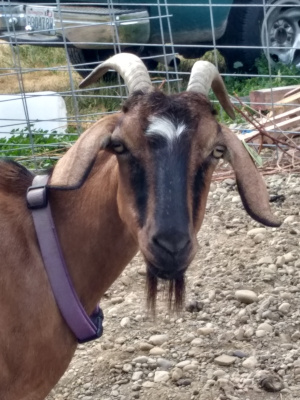
|
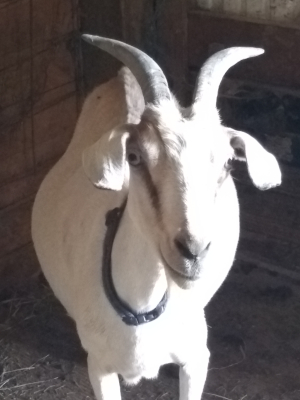
|
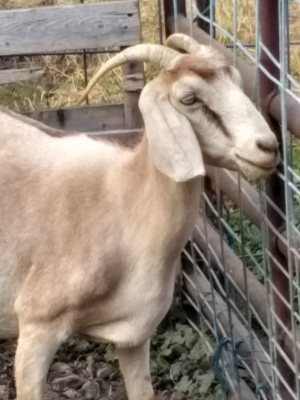
|
There are three primary income streams for Akyla Farms — meat chickens, pigs and the goat herd for vegetation management that we have managed since the farm began. The goat herd is an amazing work crew when if comes to woody vegetation and blackberries.
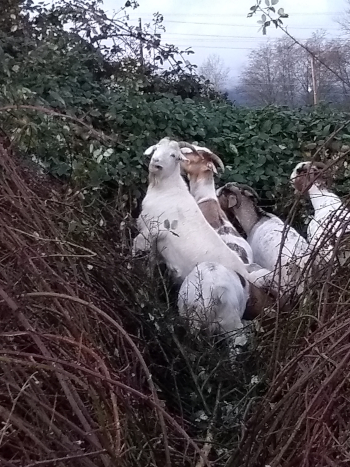
The goat herd is about 20 goats that range in age from this years kids up to 12 year olds that are favorites. They are a hodgepodge of breeds as we have used a variety of different bucks and any kids from the dairy herd spend time as foragers as they grow up after weaning.
When I get a call for a goat job I start by going to take a look as the site to make sure it is a good fit for the goats, look at the logistics of getting them to the area that needs work and making sure that I know how to get in and back out with the truck and trailer. I also discuss what they will and will not eat while they are working.
The trailer which is also their shelter is a 20 ft gooseneck stock trailer, while during the summer months they don′t need access to it as shade is the primary shelter they need. But during the rest of the year, especially if rain is in the forecast as it often is in NW WA, We feel better if they have an actual roof over them and a windbreak is definitely a plus during winter weather.
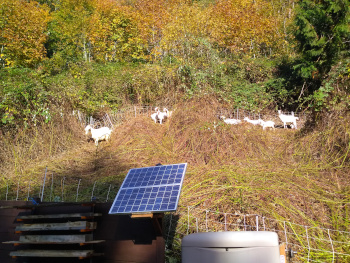
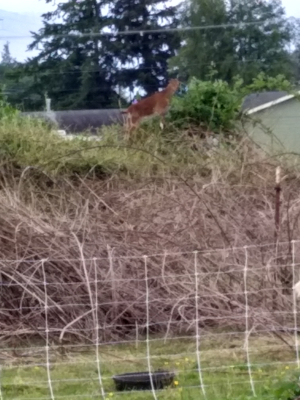
Once I have made the initial site visit a date is scheduled for the goats to arrive. On arrival day, it is usually in the afternoon that I arrive with the goats in the trailer and I commence to setting up their netting and getting them out of the trailer so they can start working. Then I finish setting up their pen by making sure they have water and the fence is electrified. Once everything is in place and the goats are happily munching away I get to leave to go home to my own bed. I then come back daily to check up on them making sure they have water and their minerals and moving them to the next pen as needed until the project is done. Then I load them into their trailer, collect their netting, water trough and mineral tubs and off we go to the next project.

I′ve had ducks for almost 10 years, but it never occurred to me to try raising them for meat. But, when Carol asked me what I wanted to add to Akyla Farms′ offerings, ducks seemed like a natural choice. So, I read a book. That′s what you do when you′re learning something new, right? I had a little experience raising chickens in a portable pasture pen and figured I could do the same with ducks, with only a few differences. I knew ducks needed a different watering system than chickens, since they need to be able to immerse their heads, so I decided to provide them with regular bucket instead of a nipple waterer. I also knew they might be a bit messier than chickens because they love to splash that water around quite a bit. Otherwise, they eat the same diet. I was ready to give them a try.
Akyla Farms runs up to 200 chickens in a single batch, normally, but I didn′t want to get in over my head on my first attempt, so I ordered a modest number of 32 Pekin ducklings from the hatchery. I didn′t want to invest in a lot of infrastructure until I knew exactly what they would need over time. Therefore, they started out life in a stock tank inside our tomato greenhouse. It was protected and warmed with a couple heat lamps. They grow FAST! Within a week, they had to move into one of those large kiddie pools. That was a bit harder to clean because of the textured bottom, so after a few days, I just removed the pool and let them have the whole greenhouse floor. Since it′s ten by twenty feet, it gave them lots of room to run around but they could still snuggle under the lamps.
Our spring weather can be unpredictable with some chilly days and some warm ones. We had a very nice streak of warm weather, so I let those 3-week-old duckies out of the greenhouse into a small area I′d temporarily fenced off with plastic netting. I thought they′d like to have something to splash around in, but they were far too small for the kiddie pool. Luckily, I had one of those giant dog igloos for my goats and the base of it made a perfect wading pool for tiny ducks. They had their first taste of grass and used the pool as a slip and slide.
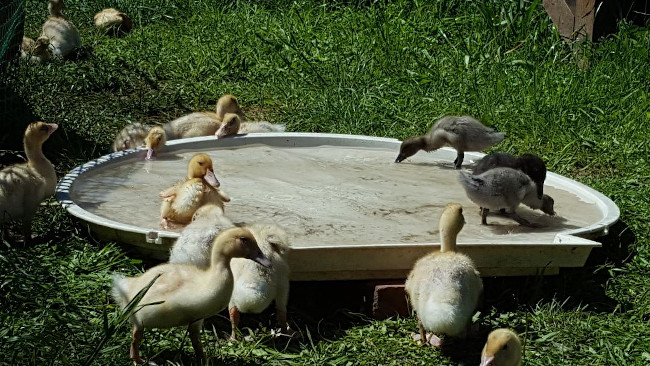
I knew the greenhouse was going to be too warm, and too small, for them to stay in any longer so I commandeered a large homemade dog kennel to be their next house. We covered it with a tarp to give them a little protection from bad weather and fenced in a nice area for them to roam and graze. When I said before that ducks are messier than chickens, I was understating the matter. Ducks make a colossal mess!! It only took two days for me to realize that their new house was going to have to become mobile for them to have a clean place to sleep at night. That meant attaching wheels to a heavy structure that was never meant to move and dragging it around with a hand truck. By this time, the ducks were getting so big, they were trashing their water bucket in just a couple hours and they really had no way of cleaning their bodies off. The kiddie pool they had spent their second week in had a large hole and wouldn′t hold water, so I stole the pool my geese use (they had a few choice words for me about that). Now the duckies had a nice big pool to bathe/drink out of, a mobile (barely) house and access to fresh grass and bugs every day. They had protection from some enormous fir trees and a scarecrow made from a sasquatch Halloween costume that I could move around the yard so hawks wouldn′t hang around.
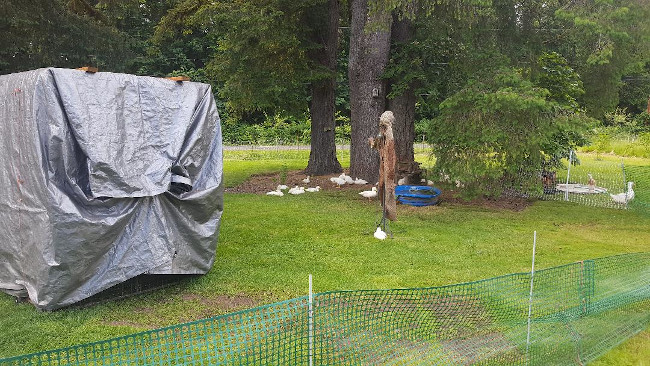
As I write this, the duckies have one week left before processing. They are nearly feathered out and I am stunned at how fast they have grown. I have learned what I needed to know for next year and will be more efficient in their care. Overall, I guess the biggest difference between ducks and chickens has turned out to be their water needs. I can′t confine them to a mobile pen 24 hours a day for that reason; they need access to lots of water. A huge plus (and a big difference from chickens) is that ducks are super easy to herd. They learn very quickly where "home " is and are a cinch to put away at night. I would like to look at livestock guardian dogs for protection for them, as well as the rest of my animals, so I don′t need to constantly worry about predators. I have really enjoyed raising these ducks and giving them the best life I could. I hope you enjoy the products of these efforts and let us know if you would like more next year!
The little piggies have arrived. They are a cross of several large breeds including Berkshire and Glouchester Old Spot and the small breed
Kune Kune. They are from the same breeder as last year and should turn out very similar. Six of the pigs are a month older and therefore should end up a few pounds heavier than the other four. None of the pigs have been vaccinated or chemically dewormed. They were given a herbal dewormer with their grain for the first few days we had them and will get it as needed.
As usual the pigs are at the Birdsview property in a panel pen to get used to us and know that we bring their grain. In about a month we will
start introducing them to the electrified netting so that they can be moved frequently. The plan for this year is to move them through the
area where the cows were fed hay.
The untreated hay for the cows comes from a local farmer that is a longtime family friend. The approximately 800 lbs round bales are about 5 ft
in diameter. For the most part we try to unroll them so that way the cows will spread their manure as they work their way through the hay. Only
having the 4 beef animals (3 cows and a young bull) it takes them 4-5 days to eat what they want of a bale. The rest of the hay is adding much
needed organic matter to the soil.
It is this leftover hay that the pigs will be spreading for us as we move them around the pasture. In the 6+ months that we have the pigs they will
be moved close to 20 times as we believe that a pastured pig should have grass and forbs in their diet along with their grain and what they root
out of the ground.
The frequent moves helps to minimize their destructive impact on the pasture and the areas where they create a moonscape will be reseeded with
a cover crop to minimize wind erosion and help feed the cows later in the year. This way the animals help each other out and regenerate the soil in
the process.
As usual we aim for a 100 lb half and a butchering date sometime in October or November. Raising the pigs each year with the frequent moves is
work but it is such a joy to see the pigs run and root and be a pig. They have a good life while we have them with the only bad (ie high stress) days
being the day we get them and the day they meet the butcher. There are still a few halves or wholes available, if interested please fill out
our pre-order form and send it to us with your deposit.
I recently came across the Organic Poultry Scorecard by the Cornucopia Institute and wanted to know how we rated. I put what I thought we should rate and would like to know if you think it should be different. For the scoring criteria go to the Conucopia website and look under Scorecards. There are 18 scored criteria, 2 non-scoring and 1 extra credit for a total of 1800 possible points.
So how did we do? 1510 out of the possible 1800 points. Not bad considering that we loose 200 points for not having any certifications. Can we do better? Definitely! The death rate is one that really concerns us as we are usually well under 5% but the last couple off years have not been good for shipping stress and we have made some other changes to hopefully get back below 5%. Are there things that you would like us to do differently? Let us know so we can think about improving even more.
I asked Gina to write this blog as she has a great story that always brings great smiles to my face. And yes before anyone asks I am THAT friend and Kevin and I were back that night willing to take her home.
In May of 2016, Sabrina came into my life. She was 7 days old, the unfortunate little sister to two big brothers who would not share their mom′s udder. Yes, Sabrina is a goat. I was asked to babysit overnight while a friend ran an out-of-town errand and by the next day, I was firmly convinced that nothing could make me give her back. I didn′t get much of an argument (okay, none at all) because bottle baby goats take a LOT of work and time and sleepless nights...
I might be confusing Sabrina with my own kid, but anyway, they are a handful, at least. Since I had no facilities to contain a very tiny goat at that time, Sabrina slept in a big Rubbermaid tub next to my bed. She woke me when she was hungry (nobody can sleep through that!) She followed me around my house and crawled in the dishwasher. She rode along to every place we went including the local brewery, a winery, my son′s school, the chiropractor′s office, and no one ever said, "No livestock allowed".

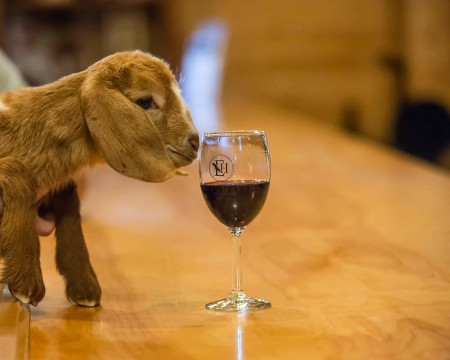
When Sabrina was about 5 weeks old, I acquired another bottle baby. He was 4 weeks old, the only survivor of triplets who was too weak to nurse at birth, and he was looking for someone who already had a sister for him to play with. Thus, Lincoln joined our lives. Two bottle babies are always better than one and now Sabrina and I had another hiking buddy. As the two of them grew, we would put them in a big dog crate and drive up the pass to go for walks along snowy glacial lakes. We took them to our favorite campground and let them bounce from rock to rock and everywhere we went, we would catch someone doing a doubletake because those "little dogs" look suspiciously like little goats!
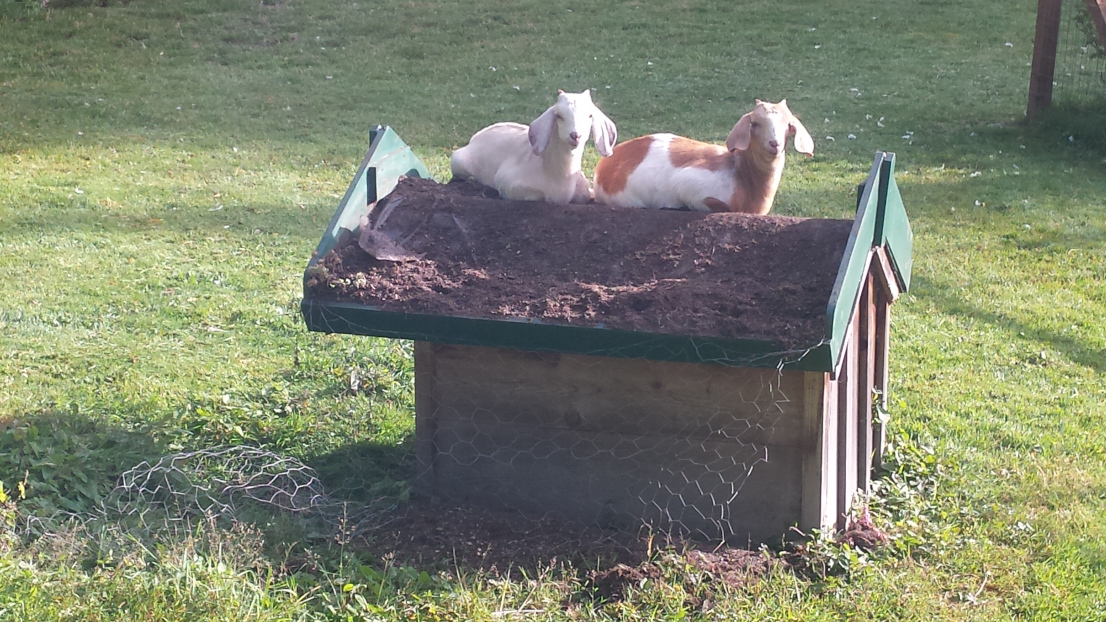

As usually happens, kids grow up, and Sabrina and Lincoln were no exception. They eventually stopped fitting in the crate and started hanging out more in their pasture and acting a little more like goats. These days, Lincoln is about 250 pounds of big hairy lapdog. He needs assurance that he is a "good goat" and that means ear rubs and scratches. Sabrina is a very independent, if somewhat stumpy, guard goat. Everyone who comes into her pasture, who is not me, gets the eyeball and ears straight out, flying nun style, and occasionally she will threaten a head butt if I don′t grab her. It is kind of a pain, but kind of flattering, too, since my "daughter" is protecting me.
I should have known from her protection of me that she would make a terrific mom, herself. She proved it on March 7th, 2021 when she gave birth to Scottie and Saffron. The neat part of having bottle babies is that they become wonderfully socialized to people, just like dogs. The neat part of having my bottle baby raise her own kids is she is imprinted on me; she naturally transfers that trust to her offspring. I get all the joy of friendly goat kids without the sleepless nights and worries!
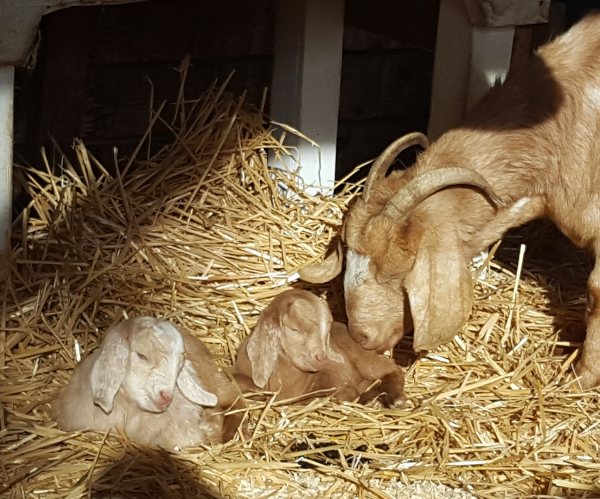
I want to dedicate this story to my beloved Australian Shepherd, Bella, whom I lost a couple weeks ago. She was a fantastic "mom" to Sabrina and Lincoln and would have certainly adopted Sabrina′s kids as well. It′s a tremendous loss to my entire family.


This past week I took a walk in the woods at our Birdsview property and took some pictures of the approaching spring and
thought I would share them with you.
 For many years I have recommended that everyone should learn a healing modality, if for no other reason than to have the
ability of doing first aid for you, your family, and any animals you may have. There are many alternatives to pharmaceuticals,
our favorite is Homeopathy. This healing modality is based on the principle of "like cures like" in other words a remedy that
will cause a set of symptoms in a healthy individual can cure those same symptoms in a sick individual.
For many years I have recommended that everyone should learn a healing modality, if for no other reason than to have the
ability of doing first aid for you, your family, and any animals you may have. There are many alternatives to pharmaceuticals,
our favorite is Homeopathy. This healing modality is based on the principle of "like cures like" in other words a remedy that
will cause a set of symptoms in a healthy individual can cure those same symptoms in a sick individual.
Homeopathy was very widely practiced in the latter half of the 19th century with many colleges and hospitals around the US. But
it was not liked by those that preferred the barbaric practices of bloodletting and purgation and was deemed as quackery and
any who practiced it ostracized and lost their medical license. Even those who consulted with homeopaths were put on notice.
So, it rapidly fell in popularity here in the US. Recently it has been more widely accepted and with the science of nanoparticles
it can now be explained how this 200-year-old medicine works.
With thousands of remedies Homeopathy can effectively prevent or treat any illness, and injuries heal faster when an appropriate
remedy is used. Here at the farm, we have successfully treated everything from simple muscle strains and proud flesh to mastitis
and broken legs. One of our first major successes was a case of suspected joint ill in a newborn goat. In a matter of hours, the
kid went from not using a leg at all to no noticeable favoring of the leg. It was amazing to witness the speed of progression to health.
 There are many benefits of homeopathy; here are our favorites...
There are many benefits of homeopathy; here are our favorites...

As you can see there are many reasons to love homeopathy, but there are reasons to be very frustrated with it also. The primary issue
is that there are so many remedies to choose from, and many remedies can be used for the same symptoms, so how does one choose? As
with learning anything new, starting with the basics will give a foundation to work on. I started with first aid and issues as they
happened, and then took some online classes as I studied and acquired more resources. I am now fairly confident in homeopathy and
some illnesses and/or injuries are rapidly taken care of, but others still stump me, so I then use other methods in my toolbox to
deal with the presenting case.
As I look through my remedies, I realize how many are used and how many I do not want to be without but there are some remedies that
are critical for us on the farm. Ipecacuanha and Chamomilla are used for every batch of chicks we raise. I have stated that the one
mandatory item in my kidding kit is Sepia for the doe that refuses to nurse her kid. And of course, the number 1 remedy for us humans
is Magnesia Phosphorica for muscle cramps.
With all the remedies out there, your favorites will be different than ours and you even may decide that homeopathy is not for you but
healing with herbs calls to you like homeopathy does to me. Hoping that whichever method you use builds on the nutrient dense diet of
pork, chicken, duck, and eggs that Akyla Farms (and Give Me Faith Farms) provides.
 Pre-orders are coming in and the chickens are going fast and there is a limited supply of the ducks so if you are interested in either
of these get your pre-order in before they are gone. Our pre-order form can be found here
Pre-orders are coming in and the chickens are going fast and there is a limited supply of the ducks so if you are interested in either
of these get your pre-order in before they are gone. Our pre-order form can be found here
Goose, duck, and chicken eggs are readily available at Akyla Farms or Give Me Faith Farms. Call, text, or email so we can have the eggs
ready for you to pick up.
Every year we answer questions from people who have never bought meat from us. Some of their questions are easy, such as, how much we charge per pound of pork or how much do the chickens weigh. Then there are the questions that take some thought and I usually do a quick web search for these answers. For instance, how much freezer space is needed for X number of chickens or how much meat is on a half a pig? One of my new books answers these questions and more by leading the reader through a series of calculations to determine how much freezer space they need to feed their family based upon real life numbers. There′s a Cow in My Freezer by Maxine Taylor is well worth the purchase price for someone interested in buying a freezer and/or purchasing meat by the quarter, half, or whole. Budgeting, selecting a farmer, cut and wrap instructions, keeping track of inventory, and more are all well covered in this easy-to-read book. We do not get anything for recommending the book, but I just want to help you to purchase your meat from Akyla Farms.
The farm is slowly waking up as spring approaches. We currently have duck eggs for sale. Gina has chicken eggs available and soon we will have chicken eggs, as well. Our first goat kid was born 2 weeks ago, so I have started milking, and the next doe is due in a couple of weeks. The first batch of meat chickens and the pigs will arrive in just over a month, so the planning is in full swing for the year.
We have kept prices at the same level as last year, but they will be increasing on May 1st of this year, so get your pre-orders in to take advantage of the lower prices! We had planned to increase our prices last year but chose to hold off since lockdowns created undue hardships for many. Some of our suppliers raised their prices last year so we need to increase our own to keep the farm sustainable. We understand that, in many ways, the economy is still in dire shape, so if you need pre- or post-payment plans, please ask and we can work something out.
Because we care about you, we highly recommended visiting a couple websites that go into detail about events in the world today and where we have been. Highwire.com, childrenshealthdefense.org and mercola.com are my three favorite sites for the issues surrounding Sars-cov-2. There are many more and, if you are interested, please email me and I will send you a list. I have previously written about our views on Covid19 and they have not changed, other than gaining more enlightenment as to who and what is behind the issues we′re facing on the local, national and world levels. All three of these websites report peer reviewed data that goes against what is being reported on the mainstream news. Many try to attack the character of the people putting this information out there, but they have a long list of credentials and accomplishments to back them up. For example, Del Bigtree and the Informed Consent Action Network (ICAN) have published that they are winning lawsuits against the CDC and FDA regarding safety studies of vaccines. Unfortunately, they are being heavily censored as are many others trying to speak the truth. To those of you who have been directly affected by the disease Covid19, we sincerely hope that you have recovered or are well on your way to recovery. There are a few questions that I want to end with in the hopes that they will help you to see through the lies that are being told.
Okay, I will get off my soapbox now.
If you have read this to the end, I appreciate you and I want to thank you for supporting a local small farm. We are looking
forward to receiving your pre-orders and, as always, if you have any questions, want more information, or would like to check
on egg availability please email, text, or call.
I live in the stunningly beautiful Skagit Valley on a little over 2 acres. My husband and I bought the place in 2012 and I became determined to turn a run down 90-year-old house and blackberry vine-laden property into a thriving homestead.
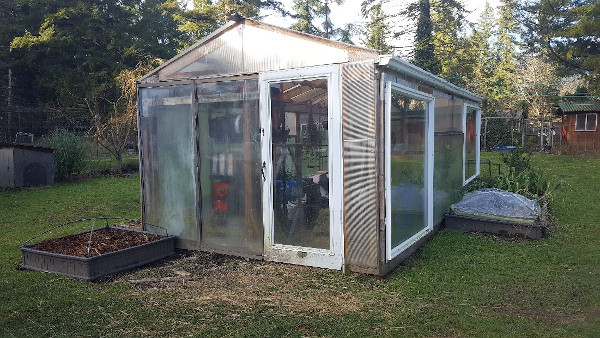
We built a glass greenhouse, recycled from our house when we upgraded the windows. The chickens had a small coop to call their own and a 3-sided shed was put up to give the horses shelter. A smaller shed with a floor was built to house my 2 rescue goats. We designated a large area for a vegetable garden and a small, mixed fruit orchard. The chickens had the run of the front yard and eliminated the ant infestation the first year they were here. I was a novice gardener and knew little about fruit trees so there was a lot of learning taking place. After a couple years, I felt we had a good start.

Fast forward to 2015, I was online asking a goat group if anyone could identify what kind of goats I had, and someone suggested a woman who could help me. As it turned out, she ran a large goat herd a little over a mile from my house and she stopped by to look. Her name was Carol of Akyla Farms, and we immediately hit it off (I am proud to call her my best friend, now). One thing friends do is introduce each other to new things. I had owned a goat in the past (Elmer, who lived at the barn where I worked and one day came home with me), and I had two rescue goats when I met Carol, but I can honestly say, she truly introduced me to goats. Now, because of her (and thanks to her) I have five goats, some with babies on the way and a young buckling as the new herd sire.
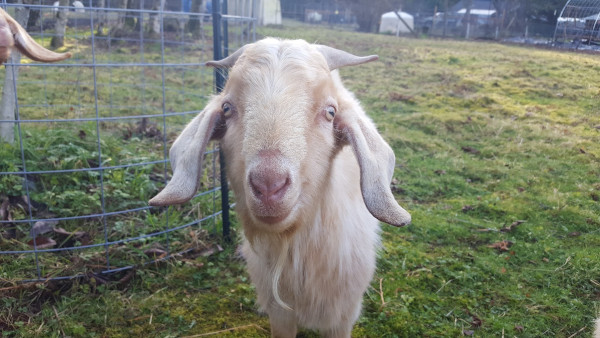
Here we are, 9 years after we started and the house has finally been completely remodeled, the property has been cleared and fenced and a bunch of outbuildings have been added, thanks to my hard working, long suffering significant other (I swore I only wanted six chickens). We have a larger garden and the fruit trees are producing apples, peaches, nectarines, plums, pears, figs, and quince. A second greenhouse was added to the garden specifically for my husband′s tomatoes. The chickens now number around 30 and layer ducks are due in April. Three bossy geese run things in the orchard and I have a herd dog who long ago decided to live by the mantra, "If you can′t beat them, join them". In other words, my goats will not be herded. And herding cats and chickens gets old when all they do is scatter in all directions.
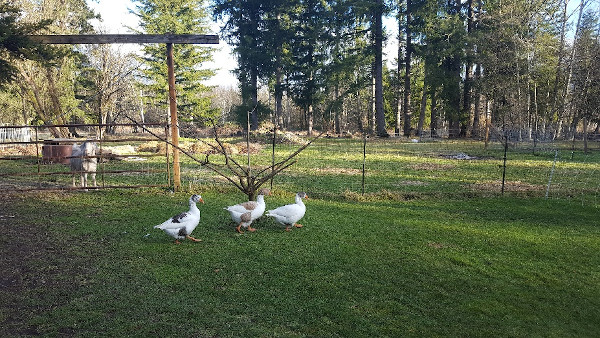
I have learned to make goat cheese and goat′s milk soap, I can or freeze the produce from our garden,
bake sourdough bread, and make
endless gallons of chicken stock. My goals are to produce most of my family′s food, to raise chickens
and ducks for meat and eggs, to
raise geese and, of course, goats. We are also hoping to add pigs this year for meat and to help the
goats with brush control.
Welcome to my farm!


As the farm continues to hibernate for the winter, Kevin and I have the opportunity to spend some time on our hobbies
of hand-spinning and weaving. There is just something about taking pieces of fluff and turning them into yarn and then
using that yarn to make an item that can be enjoyed for years to come. We have made shawls, scarves, boxes, flowers,
dragonflies, blankets, pillows and many other things.
The current spinning herd includes one antique and one modern wooden wheel, a wheel made out of PVC pipe, and a little
electric one. There is one more on the way — a larger electric wheel that I am calling Big Brother. Each wheel has its
own personality and what it excels at. We don′t use the antique as it is very hard to keep the wheel turning. It is,
 therefore, looking for a new home where it can be used to spin beautiful yarn. "The Traveler" is Kevin′s wheel and has
a lot of ratios for a wide range of spinning capabilities from fine to thick. Then there is "Babe", which is my first
wheel and while it has minimal adjustments, I can do everything from fine to thick on it with my usual inconsistently
consistent yarn being spun. The "Nano" is just plain cute in that it is so small that it fits in the palm of my hand
and it excels at making very fine yarn. The one that is coming is a larger version of the Nano, hence the name Big Brother,
with a bobbin that purportedly will hold 8 oz of fiber (the Nano holds 2 at max and the others will do 4 nicely).
therefore, looking for a new home where it can be used to spin beautiful yarn. "The Traveler" is Kevin′s wheel and has
a lot of ratios for a wide range of spinning capabilities from fine to thick. Then there is "Babe", which is my first
wheel and while it has minimal adjustments, I can do everything from fine to thick on it with my usual inconsistently
consistent yarn being spun. The "Nano" is just plain cute in that it is so small that it fits in the palm of my hand
and it excels at making very fine yarn. The one that is coming is a larger version of the Nano, hence the name Big Brother,
with a bobbin that purportedly will hold 8 oz of fiber (the Nano holds 2 at max and the others will do 4 nicely).
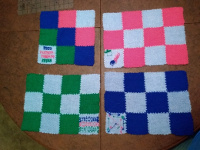 For weaving we have a conventional table loom with 8 harnesses that will hold long, relatively narrow warps for weaving
and an assortment of small and medium frame looms in square, rectangle, triangle and dragonfly shapes. The individual
weavings can be joined together to make anything that comes to mind. Kevin greatly prefers his table loom but has little
patience for my frame looms, whereas I much prefer my frame looms as I don′t have to spend so much time in getting the
loom warped!
For weaving we have a conventional table loom with 8 harnesses that will hold long, relatively narrow warps for weaving
and an assortment of small and medium frame looms in square, rectangle, triangle and dragonfly shapes. The individual
weavings can be joined together to make anything that comes to mind. Kevin greatly prefers his table loom but has little
patience for my frame looms, whereas I much prefer my frame looms as I don′t have to spend so much time in getting the
loom warped!
Here are some pictures of what I have created recently from my handspun fiber. 
 .
.
For Christmas this year, one of my asked for gifts was a book called Dirt to Soil by Gabe Brown. It is a story of one family′s
switch to regenerative agriculture. As I read the first few chapters, I thought to myself, "I already know this stuff." With my
Masters in Animal Science and years as a small Farm Planner and livestock grazer, I am very familiar with the subject of pasture
management. However, as I read on, I began to realize how non-diverse our pastures are. They contain mainly grasses with a few
legumes and are lacking the diversity that nature craves and thrives on. One of our primary goals for the cows and goats is to
have them grazing throughout the year and eliminate the need to supplement with hay.
Hay is one of the biggest expenses for Akyla Farms, as with most livestock farms, but there are many farms that do not feed any
stored forages and reside in much harsher climates than ours. It is possible to do if one learns how to think outside the box.
Current plans are to seed our pastures with a more diverse array of legumes, grasses, and forbs. Legumes include plants such as
clovers and alfalfa. Grasses include cool season varieties such as orchard grass and fescue, and warm season varieties such as
Bermuda grass and corn. Forbs are generally broadleaf plants that are not grasses, nor are they woody, and include plants such
as plantain, dandelions and sorrel.
As with each new year there is always lots of promise, hope and enthusiasm. We are well into the planning for this year with some plans already set-in motion and, as I learn more (there are several more farming books for me to read this year) there will be plenty of new ideas to implement. Looking forward to seeing you on the farm for eggs and chicken pick-ups.
Live weight, carcass weight, hanging weight, and dressed weight are all terms that can be confusing for consumers.
Depending on the species, the amount of usable product that makes it to your dinner table can vary greatly.
To get the most out of your money, make use of everything that you pay for, even items not typically found in the grocery store.
This is the weight of the animal as it is still walking around. For one of our chickens, a typical live weight would be about six pounds.
These terms all describe the same thing. They are the weight of the carcass after the internal organs, lower legs, tails, heads, and
sometimes skin or hide are subtracted. Our chickens, for example, sell whole. For other animals, dressed weight is what we use to
calculate the amount due. In other words, the customer is not paying for the weight of the hide or any bones or organs not included
in the order.
For the adventuresome, this is where additional items can be had for little or no cost. To get pork and beef extras, you would need
to be present at time of butcher. These items include hide, intestines (for sausage casings), feet (make great chews for dogs),
and any organs you would like. The heart, liver, and kidneys can go with the butcher but must be requested.
This is what you get at the butcher when picking up a half or whole pig or steer. It also refers to a sold-as-whole chicken, or
individual packages of wings, thighs, drumsticks, and/or breasts, such as you would see in the grocery store.
Bones are excellent for making homemade stock and I always encourage my customers to retain the fat from the pig they buy from us.
Pig fat is very easy to render and can be used in a multitude of ways in the kitchen and around the house.
Here is an example of how a typical sized chicken from Akyla Farms breaks down.
5.94 lbs Live weight
-1.78 Minus internal organs, head, tail, feet, feathers
4.16 Carcass weight
-0.91 Minus backbone, extra fat, skin, breast bone
3.25 Cooking weight of wings, drumsticks, thighs, breast meat
For pork and beef, the percentages are a bit different and some parts are in different places. Ordering different cuts will also
change the take home weight as the butcher will remove more or less bone, depending.
Hopefully this clears up some of the confusion regarding different weights and terms and helps you get the most out of your purchase.



Corona is forcing all of us to change and adapt as we tread through the unknown of what the government is going to do next and how
the public is going to respond. Here at Akyla Farms our day-to-day activities have not changed much other than Kevin getting off
work a little earlier. He just went back to full time this week. He works warehouse for a plumbing supply company which is
categorized as sanitation and therefore essential. For me, Carol, my day is still full of chores with milking goats, moving meat
bird pens, feeding pigs and making sure that the goat herd has enough to eat.
Where we are having to adapt is giving extra time for supplies to arrive. The orders for the homeopathic remedies and mineral supplements
are taking longer to get shipped. And we should have ordered batch 2 meat birds sooner. For the last couple of years, ordering a month
in advance has worked. Not so for batch 2, they are due to arrive June 2nd which is 2 weeks behind what we figured out back in February
when we set our schedule for this year. So now Batch 2 will be processed on August 8th, 9th and 15th. If you have put a pre-order in for
Batch 2 and have not gotten an email from me in regards to rescheduling pick-up please contact me as I have not gotten your order.
By the way something that I started last fall is to do my accounting each Friday. So this is when I enter the pre-orders and send out
receipts. If you have sent in your pre-order for pork or chicken and have not heard back from me please let me know.
Another change that has happened, not directly due to the issues facing us all, is that we now have a honor system for eggs. They are
in a non-working freezer on the west side of the house and there is a wood payment box in the freezer. Plenty of chicken, duck and
goose eggs are available. All of the eggs are unwashed. If you would prefer washed, contact us with how many and which kind you want
and we will get some washed for you.
One other adaptation that directly applies to you is that we have decided to not raise our prices this year as it just didn′t seem right
with so many not getting their regular pay checks and small brick and mortar businesses questioning whether they are going to be able to
open let alone be a business.
If you are thinking about getting a whole or a half pig now is the time to get your pre-order in as we are getting close to selling out for
this year. The pigs are doing well and enjoying their pasture and organic grains with milk from our dairy does and surplus eggs. Batch 1 of
meat chickens are also on track to be processed the first 2 weekends in June, some are still available to be on your table. If getting chicken
in June look for a reminder email the week before.
Hoping that we will be able to have a normal more similar to what we had 6 months ago than what is going on now.
 Spring is coming and the farm while busy all year around is starting to see the grass growing and buds forming on the trees and shrubs.
With the coming of Spring the first batch of chicks have been ordered and we will be making plans to pick up pigs so it is time to start
taking pre-orders.
Spring is coming and the farm while busy all year around is starting to see the grass growing and buds forming on the trees and shrubs.
With the coming of Spring the first batch of chicks have been ordered and we will be making plans to pick up pigs so it is time to start
taking pre-orders.
By taking pre-orders we get to gauge the level of interest in our products by you and it provides a little cash flow after the winter
when we don′t have much sales.
We will again have whole meat chickens and fall pork by the half or whole. Eggs are also available at the home farm in Sedro Woolley.
After many years of not raising our prices and crunching numbers for last year we have decided to have a slight price increase. To say
thank you for placing pre-orders the new prices will take effect May 1st. So get your pre-orders in now at last years prices.
With last years addition of ducks and geese we now have duck and goose eggs available along with the traditional chicken. Please call/text
or email to check availability.
The first batch of chirpy, fluff balls (aka broiler chicks) have been ordered and should be arriving on April 2nd. Seeing the little
chirps run around in the brooder is always a warm feeling. Let us know if you would like to stop by to watch the fluff balls, just need
to be quick as they don′t stay that way for very long.
Download your pre-order form hereand send it to us to get your order on our list. Checks are preferable but can take credit/debit over
the phone if you prefer. And of course if you want to stop by for eggs we can take your order then with cash, check or debit/credit.
We recently gave a farm tour to a new customer and were asked about any certifications or permits that we have. There are many
different certifications that we could garner: Organic, Animal Welfare Approved, Grassfed would be at the top of the list.
Our basic belief is that it is the integrity of the farmer that is more important than any piece of paper. There is no one
following us around every day to make sure that we do not buy the Roundup and apply it to our pastures or use the pharmaceutical
meds on our animals for every little sniffle. We strive for animals that are healthy without the use of drugs and believe that animals
need to be managed in a way that mimics the natural environment as close as we can. Hence we use minimal shelters, herds on pasture
and homeopathy as our core.
We do acquire the Pasture Poultry Permit that legally allows us to process and sell whole chickens. This means that we are inspected
on a butchering day each year by the WA State Department of Agriculture. In the many years that we have processed poultry, each with
the permit, we have never scored less than 100 and have taken any suggestion by the inspector and improved upon our setup and processing.
While the permit allows us to process whole chickens and sell them within 48 hours we are not allowed to cut the birds up to separately
provide wings, breasts, legs or thighs. As part of the processing we can separate and offer feet and organs (heart, liver, spleen, gizzard
and the occasional testicles/ovaries and lungs). Let us know on the pre-order form if you would like feet and/or organs, or when you pick
up your whole chickens.
By selling the larger animals (cows, pigs, goats) by the whole, half or quarter we are working with the butcher on your behalf to process
your animal or part of. This is considered custom meat processing. In order to sell you a single package of chops or ground meat the animal
has to be processed at a USDA inspected facility. There is a mobile unit that does operate in the area but there is a long wait list to
become a member of the cooperative that operates it. Also, in the past we have sent a couple of pigs this route and we received a lot
less money because so much more was taken off of the carcass before hanging weight was taken. The parts taken off, including backfat/lard,
and any other offal is immediately put into a bucket and made unfit for human consumption, this is a requirement at USDA Inspected facilities.
In the Custom route that we offer these extra parts can be saved and used for traditional dishes, pet food for local raw feeders (most of the
organs from the animals we butcher feed our dogs or other local raw feeders) or composted and returned to the pastures where the animals were
raised. If you would like some of the offal from butchering let us know and we can work with you to utilize this resource.
We are starting to plan for this year and will be taking pre-orders by the end of February for chicken and pork. Also sometime this late
spring/early summer we will have a veal calf available. Stay tuned for dates and further information.
As always if you have questions please feel free to ask,
Carol and Kevin
barnyard@akylafarms.com
Chicken faq
It′s about that time again for chickens and wanted to answer some of your questions about our chickens. If I don′t get to your question please ask.
What do your chickens eat?
When the chicks arrive we start them on hard boiled eggs (from our flock of organically fed chickens) and raw goats milk (from our dairy goats that are fed a non grain, mostlry organic diet) for the first day. Then for the rest of their time in the brooder they eat a certified organic grain mix. When they go out to the pasture the grain mix transitions to a grower feed, also certified organic. Their diet also consists of grasses, seeds, other vegetation and any bugs that happens to wander into their pen.
How Long does it take for the chickens to grow?
About 10 weeks, the first 3 are in the brooder and the rest is out in the pasture pens that are moved daily to fresh pasture.
What is the average weight of a chicken?
4.4 lbs is the average weight. The birds grow about an additional half a pound in the week between the processing dates, so if you would prefer more lighter weight birds select the first weekend for a batch, the second weekend the birds will be a bit heavier. The weight range is 3.3 to 5.9 lbs per bird.
How long have you been raising meat chickens?
We started in 2006.
Are the birds cleaned when I pick them up?
The birds are defeathered and gutted, they look very similar to what you would find in the grocery store.
When can I pick up my birds?
We try to have the gate open by 2pm on processing days. We process the birds in the morning but don′t always get an early start and may still be processing or cleaning up/getting ready for packaging at 2. Our next processing days are July 20th , 21st and 27th.
Do you have birds available at other times of the year?
Because we prefer to process our own birds for quality control, the chickens legally have to go directly to you, the consumer, within 48 hours of processing. We also only raise birds in the spring/summer months and our processing setup is outdoors so processing in the wetter/colder months of the year is not a viable option.
Can I come watch processing?
We enjoy knowing that our customers can watch us and see for themselves how their food makes it to their table, just let us know that you want to come so we can open the gate for you to come in. We usually are processing from 8am to noon on processing days.
How much do you charge per lb?
$6/lb which makes the average bird $26.40.
What breed of chickens do you raise?
Freedom Rangers. The genetics come from France and the Label Rouge Program that denotes high quality pastured chickens.
Are the chickens organic?
They are not certified organic but are raised organically.
Let me know if you have a question that I did not cover.

"If it′s not 1 thing it′s 5 others" has become one of my mantras. My life is very busy and I′m sure yours is too.
I recently learned that we can only make so many decisions in a day and that coupled with having only have so much
energy each day means that many things don′t get done if they are pushed off. For some of us just getting out of bed
can take a good percentage of our daily energy allotment. For others making daily routine decisions like what to eat
for dinner is not easy after a long day of decision making at work or with the kids.
One thing that I have learned that really helps my day flow, especially at the end of the day is to have a meal plan.
I usually try to set it up each month, but for others a weekly plan works well. The monthly plan has worked well for me
because I have been stocking up on the staples that I need based upon the meal plan through a distribution company. Am
thinking about switching to a weekly meal plan because this means that I only need to come up with 7 meals instead of the
28. Also, I don′t do the monthly stock ups as much as I used to because I want to support local.
Here are 2 templates to download that I use for meal planning. The monthly one is actually 28 days and I usually
put in any day long events or evening meetings as then I can plan for leftovers or quick and easy meals for those nights.
The weekly one is actually my Weekly To Do template where I use the table portion to put in any appointments,
things to do that day, planned meals, etc and then the bottom portion I use for other activities that I would like to work
on for the week, including any groceries that I may need to acquire.
Let me know if either of these help you. There are also phone apps if you prefer that route.
Early next month, June 1st and 8th is processing for our first batch of chickens this year, if you havenít
put in your pre-order yet we would love to see it. We also have plenty of eggs available.
Looking forward to seeing you in early June when picking up your chickens.
Carol
Monthly Meal Planning Chart blank.odt
Weekly To Do List template2.odt
Despite the white stuff falling and the blanket of white still in Birdsview from last months weather, Spring is coming! Along
with the warmer temperatures and new green growth
comes goat kids (first ones are due any day), chicks, piglets and eggs. It also means that we are starting to gear up for the
production season and are ready to take pre-orders for chicken and pork.
For chicken that tastes like what Grandma used to have, we have some in the freezer from last year for $6/lb, just let us know
when it would work for you to stop by or depending on how many you would like we could deliver.
If you want to get your Chickens day of processing fresh or Pastured Pork or Grass Finished Beef please fill out the
pre-order form and send it in with your deposit. We can also take deposits via
credit/debit over the phone or in person if you prefer. This will put your name on our Pre-ordered list to keep you in
the loop as processing dates get closer.
Fresh chickens will be available the first 2 weekends of June and the last 2 weekends of July. On these dates we will be
processing in the morning with pick up available in the afternoon here at the farm. If you want to see the processing we
just need to know to expect you to have the gate open. will be processed multiple times during the summer months, usually
early June, early August and late September. Pork and beef are processed based upon when they are at finishing weight which
we try to aim for October but it doesn′t always work out that way.
For eggs from organically fed hens that roam the barnyard, scratching for bugs just give us a call/text at 360-941-1533 or
Email to make sure that the ladies are laying an
ample supply and we can set some aside for you to pick up at your convenience at the home farm in Sedro Woolley. Eggs are
$6/doz, cash or check works great and credit/debit is also an option.
If something doesn′t make sense please just tap here and let me know so that I can clarify.
As always if you have any other questions or want a tour of Akyla Farms just let us know.
Thanks for supporting a local small farm
Carol